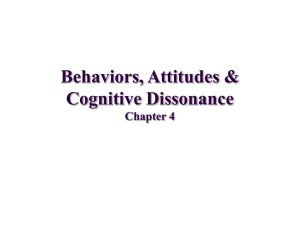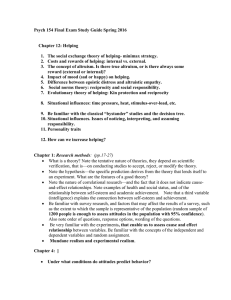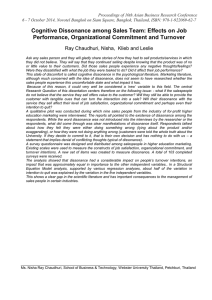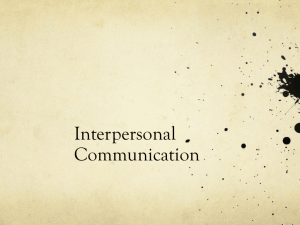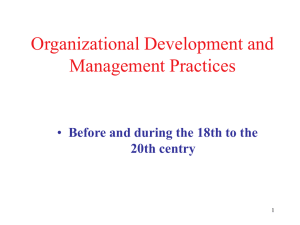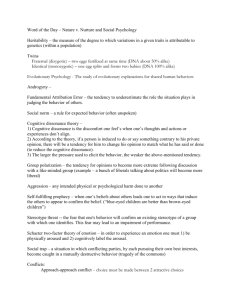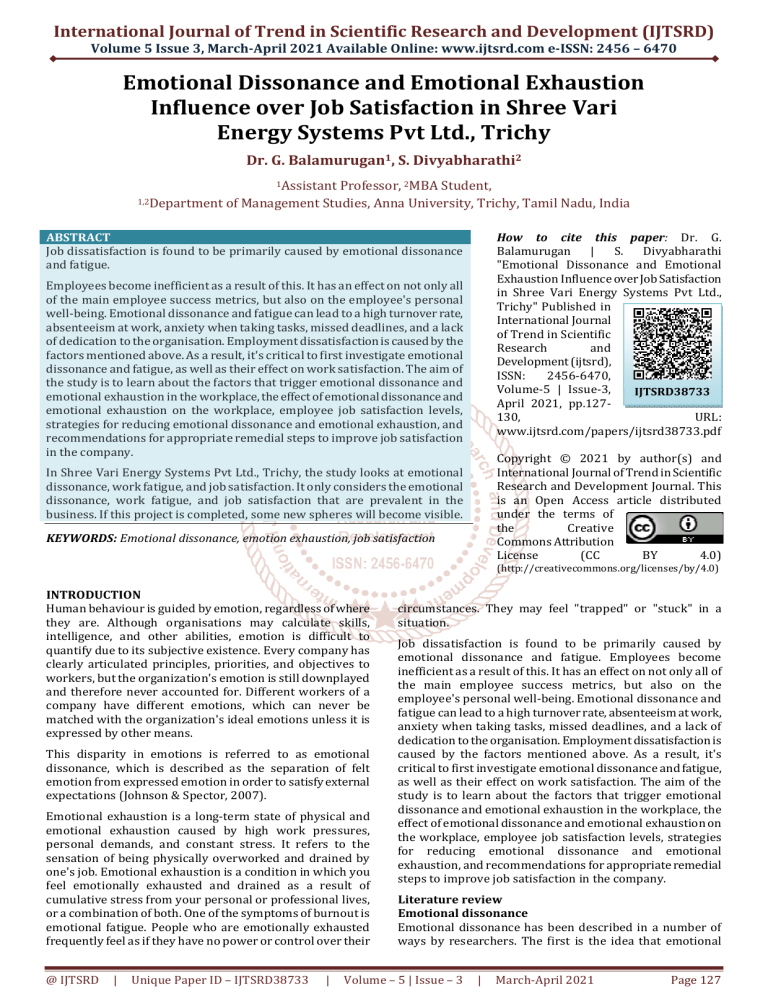
International Journal of Trend in Scientific Research and Development (IJTSRD)
Volume 5 Issue 3, March-April 2021 Available Online: www.ijtsrd.com e-ISSN: 2456 – 6470
Emotional Dissonance and Emotional Exhaustion
Influence over Job Satisfaction in Shree Vari
Energy Systems Pvt Ltd., Trichy
Dr. G. Balamurugan1, S. Divyabharathi2
1Assistant
Professor, 2MBA Student,
1,2Department of Management Studies, Anna University, Trichy, Tamil Nadu, India
How to cite this paper: Dr. G.
Balamurugan
|
S.
Divyabharathi
"Emotional Dissonance and Emotional
Exhaustion Influence over Job Satisfaction
in Shree Vari Energy Systems Pvt Ltd.,
Trichy" Published in
International Journal
of Trend in Scientific
Research
and
Development (ijtsrd),
ISSN:
2456-6470,
Volume-5 | Issue-3,
IJTSRD38733
April 2021, pp.127130,
URL:
www.ijtsrd.com/papers/ijtsrd38733.pdf
ABSTRACT
Job dissatisfaction is found to be primarily caused by emotional dissonance
and fatigue.
Employees become inefficient as a result of this. It has an effect on not only all
of the main employee success metrics, but also on the employee's personal
well-being. Emotional dissonance and fatigue can lead to a high turnover rate,
absenteeism at work, anxiety when taking tasks, missed deadlines, and a lack
of dedication to the organisation. Employment dissatisfaction is caused by the
factors mentioned above. As a result, it's critical to first investigate emotional
dissonance and fatigue, as well as their effect on work satisfaction. The aim of
the study is to learn about the factors that trigger emotional dissonance and
emotional exhaustion in the workplace, the effect of emotional dissonance and
emotional exhaustion on the workplace, employee job satisfaction levels,
strategies for reducing emotional dissonance and emotional exhaustion, and
recommendations for appropriate remedial steps to improve job satisfaction
in the company.
Copyright © 2021 by author(s) and
International Journal of Trend in Scientific
Research and Development Journal. This
is an Open Access article distributed
under the terms of
the
Creative
Commons Attribution
License
(CC
BY
4.0)
In Shree Vari Energy Systems Pvt Ltd., Trichy, the study looks at emotional
dissonance, work fatigue, and job satisfaction. It only considers the emotional
dissonance, work fatigue, and job satisfaction that are prevalent in the
business. If this project is completed, some new spheres will become visible.
KEYWORDS: Emotional dissonance, emotion exhaustion, job satisfaction
(http://creativecommons.org/licenses/by/4.0)
INTRODUCTION
Human behaviour is guided by emotion, regardless of where
they are. Although organisations may calculate skills,
intelligence, and other abilities, emotion is difficult to
quantify due to its subjective existence. Every company has
clearly articulated principles, priorities, and objectives to
workers, but the organization's emotion is still downplayed
and therefore never accounted for. Different workers of a
company have different emotions, which can never be
matched with the organization's ideal emotions unless it is
expressed by other means.
This disparity in emotions is referred to as emotional
dissonance, which is described as the separation of felt
emotion from expressed emotion in order to satisfy external
expectations (Johnson & Spector, 2007).
Emotional exhaustion is a long-term state of physical and
emotional exhaustion caused by high work pressures,
personal demands, and constant stress. It refers to the
sensation of being physically overworked and drained by
one's job. Emotional exhaustion is a condition in which you
feel emotionally exhausted and drained as a result of
cumulative stress from your personal or professional lives,
or a combination of both. One of the symptoms of burnout is
emotional fatigue. People who are emotionally exhausted
frequently feel as if they have no power or control over their
@ IJTSRD
|
Unique Paper ID – IJTSRD38733
|
circumstances. They may feel "trapped" or "stuck" in a
situation.
Job dissatisfaction is found to be primarily caused by
emotional dissonance and fatigue. Employees become
inefficient as a result of this. It has an effect on not only all of
the main employee success metrics, but also on the
employee's personal well-being. Emotional dissonance and
fatigue can lead to a high turnover rate, absenteeism at work,
anxiety when taking tasks, missed deadlines, and a lack of
dedication to the organisation. Employment dissatisfaction is
caused by the factors mentioned above. As a result, it's
critical to first investigate emotional dissonance and fatigue,
as well as their effect on work satisfaction. The aim of the
study is to learn about the factors that trigger emotional
dissonance and emotional exhaustion in the workplace, the
effect of emotional dissonance and emotional exhaustion on
the workplace, employee job satisfaction levels, strategies
for reducing emotional dissonance and emotional
exhaustion, and recommendations for appropriate remedial
steps to improve job satisfaction in the company.
Literature review
Emotional dissonance
Emotional dissonance has been described in a number of
ways by researchers. The first is the idea that emotional
Volume – 5 | Issue – 3
|
March-April 2021
Page 127
International Journal of Trend in Scientific Research and Development (IJTSRD) @ www.ijtsrd.com eISSN: 2456-6470
dissonance is a precursor to emotional labour, which is
described as "the effort, preparation, and control required to
convey organizationally desirable emotion during
interpersonal transactions" (Morris and Feldman, 1996, p.
987). . Another viewpoint holds that emotional dissonance is
a component or factor of emotional labour. To put it another
way, emotional dissonance is the act (or labour) of
suppressing or expressing feelings that did not exist at the
time. Finally, some people define emotional dissonance as an
employee's psychological conflict as a result of his emotional
labour.
Emotional dissonance has a positive relationship with work
fatigue and a negative relationship with job satisfaction,
according to Morris and Feldman (1997). Employee strain is
caused by emotional dissonance, which may contribute to
low self-esteem, isolation from work, and depression.
Vennila and Vivekananda investigated the effect of emotional
dissonance on work fatigue, job satisfaction, and turnover
intentions among IT employees in a study published in 2017.
Emotional dissonance leads to lower work satisfaction,
according to an observational study of 246 workers from
different IT industries in Coimbatore.
Wegge, Van Dick, and Von Bernstorff (2010) studied 161 call
centre workers. Positive and negative affectivity were used
to investigate emotional dissonance, with the goal of
determining if negative affectivity has a positive impact on
emotional dissonance and positive affectivity has a negative
impact.This research used data from eight call centres in
Germany that were chosen using an incentive sampling
strategy. A total of 161 of the 300 questionnaires distributed
were available and statistically evaluated. Emotional
dissonance is linked to lower motivation and well-being,
according to the findings of this research. It also
demonstrates that negative affectivity has a positive impact
on emotional dissonance whereas positive affectivity has a
negative impact. This research also attempted to determine
which emotions are fabricated or concealed, revealing that
emotions such as love, boredom, and indignation are often
faked or hidden.
Emotional exhaustion
According to Zapf et al. (2001), the production of emotional
exhaustion can be predicted by interactions between
organisational stressors and emotional demands due to the
combined effect of lack of perceived client reciprocity when
emotional demands are high and lack of perceived
organisational reciprocity when organisational stressors are
high. However, emotional demands can make a specific
contribution to emotional exhaustion, as emotional
dissonance, by definition, may function as a stressor
independent of other organisational stressors. In Zapf et
al(2001) .'s comparison of the relationship between
emotional labour variables, organisational variables, and
social variables in the prediction of burnout across a variety
of service workers, including call centre employment,
emotional labour variables were found to have a particular
contribution to burnout above and beyond that of other
variables. In the prediction of emotional fatigue, interaction
effects between task-related stressors and emotional
dissonance were also observed.
Emotional dissonance on job satisfaction
Similarly, Cote and Morgan (2002) looked into the effects of
emotional dissonance on work satisfaction and plans to quit.
@ IJTSRD
|
Unique Paper ID – IJTSRD38733
|
The study included 111 working college students, including
78 females and 33 males. Data was collected at two points in
time, separated by four weeks, to allow for changes in
emotional control, job satisfaction, and intentions to leave.
The results showed that suppressing negative emotions
lowers job satisfaction, which increases the likelihood of
quitting, while amplifying positive emotions raises worker
job satisfaction.
Emotional dissonance, job satisfaction and work stress
Tewksbury and Higgins (2006) investigated the impact of
mental dissonance on correctional personnel in two jails in
the United States. It aims to investigate the role of emotional
dissonance and perceived job stress among the 228 prison
staff members who took part in the research. A 68-item
questionnaire was used in the study, which included
questions about emotional dissonance, job satisfaction, and
work stress. According to the findings, emotional dissonance
induces work stress, which in turn affects employee
satisfaction with their employment.
Emotional dissonance, job performance and job
satisfaction
Julian (2008) tried to figure out how customer service,
emotional dissonance, work success, and job satisfaction are
related. This exploratory research was conducted using
three case studies involving a department store, a courier
service, and an airline. From January to March 2005, top
management and service personnel from these three
companies were interviewed face to face. For the report, a
total of 20 interviews were conducted. According to the
findings of this qualitative analysis, when an employee's true
feelings and the emotions conveyed are in conflict, it has a
detrimental impact on work performance and customer
orientation.
Influence of emotional dissonance
Cheung and Tang (2010) used a stress pressure outcome
model to investigate the impact of emotional dissonance on
subjective health and work satisfaction among Chinese
service employees. The researchers conducted two studies,
one cross-sectional and the other longitudinal. For the first
sample, data was collected from 271 workers, the majority of
whom were women, using standardised questionnaires.
Emotional dissonance predicted work pressure and job
satisfaction at various points in time, according to the
findings.
Yoh (2012) investigated emotional labour using both a jobfocused and an employee-focused approach. Each measure
of emotional labour was examined for its impact on job
stress, customer orientation, and job satisfaction. The
participants for this study were 193 saleswomen from
apparel department stores, with an average age of 33 and a
range of 19 to 51 years old. They were chosen using the
snow sampling process
Job satisfaction
Job satisfaction is an amalgamation of physiological,
psychological, and numerous other environmental factors
that lead an employee to conclude that he is happy with his
job, according to a review study conducted by Knerr in 2006.
Job satisfaction is a significant outcome of why a person
wants to go to work and how he acts during and after work
(Sharma and Jyoti, 2006). It's also been described as the
pleasure and contentment derived from one's work (Kevin,
House and Dowell, 1998).
Volume – 5 | Issue – 3
|
March-April 2021
Page 128
International Journal of Trend in Scientific Research and Development (IJTSRD) @ www.ijtsrd.com eISSN: 2456-6470
Since it is critical for both workers and organisations, job
satisfaction is one of the most researched topics. It's one of a
job's most crucial psychological characteristics. It refers to
how workers feel about their jobs, both positively and
negatively (Ghosh and Ghorpade,1980). It is an employee's
overall positive influence or feeling about his or her work.
Job satisfaction refers to an employee's attitude toward his
or her job, as well as other associated factors and life in
general. Job satisfaction is also described by Robbins (2001)
as one's attitude toward one's job. These behaviours are
linked to the working environment, equal pay, salaries,
supervision, and prospects for advancement, among other
things.
Job satisfaction is an amalgamation of physiological,
psychological, and numerous other environmental factors
that lead an employee to conclude that he is happy with his
job, according to a review study conducted by Knerr in 2006.
Job satisfaction is a significant outcome of why a person
wants to go to work and how he acts during and after work
(Sharma and Jyoti, 2006). ). It's also been described as the
pleasure and contentment derived from one's work (Kevin,
House and Dowell, 1998).
Emotional dissonance reduction strategy
Integration of emotional control and emotional intelligence,
which would benefit individuals by helping them to form
emotion from the earliest point and not only regulate
emotion but also leave space for emotion to emerge (Ainize
Pena Sarrionandia, Moira Mikolajczak& James J Gross, 2015),
and use of therapy intervention are examples of long-term
emotional dissonance mitigation strategies. Increased
socialisation, greater identity definition, better functional
emotional management technique, emotional sensitivity,
improvement of adaptive behaviour response, and improved
performance were all benefits of the therapy intervention
(Francesca
Menozzi,
NicoGizzi,
MariateresaTucciNazarenaPatrizi& Mauro Mosca, 2016).
Tracy, Sarah J., 2005) after considering the causes and effects
of emotional dissonance, it is clear that understanding how
to minimise emotional dissonance is critical. Identity, i.e.,
helping employees preserve their identity rather than
allowing their job to define who they are, strength, i.e., giving
employees some job control, use of secret transcripts, role
distancing behaviour, i.e., teaching employees to separate
themselves from their job role to feel at ease, strategic
engagement, and organisation are some of the ways to ease
or minimise the negative effects of emotional work
Company overview
Shreevari Energy Systems Private Limited (SES) is the first
and foremost organisation of outstanding engineering
professionals who proudly provide a full range of Products
and Services for the Process and Energy Industries in a
capable and cost-effective manner. SES is an ISO 9001:2008
accredited company. It is a group of devoted and committed
Engineers with advanced academic credentials and extensive
field experience. Its success is built on the strength of its
advanced engineering capabilities, which are backed up by a
dedication to quality and customer loyalty as evidenced by
its accreditations.
Its engineers and consultants have a wealth of expertise and
have achieved Technical Mastery in their fields. As a result, it
focuses its attention on delivering services of the highest
quality and experience, resulting in excellent value for its
clients at a low cost
Objectives of the study
To identify the strategies to reduce emotional
dissonance, emotional exhaustion in organization.
To study the impact of emotional dissonance and
emotional exhaustion on the employees.
To understand the job satisfaction level of among the
employees organization.
To analyse the factor influencing emotional dissonance
and emotional exhaustion on job satisfaction in the
organization.
Framework:
Scope of the study
In Shree Vari Energy Systems Pvt Ltd., Trichy, the study
looks at emotional dissonance, work fatigue, and job
satisfaction. It only considers the emotional dissonance,
work fatigue, and job satisfaction that are prevalent in the
business. If this project is completed, some new spheres will
become visible.
@ IJTSRD
|
Unique Paper ID – IJTSRD38733
|
Limitations of the study
It was only supposed to be a three-month project. As a result,
a time limit was imposed. Shree Vari Energy Systems Pvt Ltd.
in Trichy is the focus of the study.
Volume – 5 | Issue – 3
|
March-April 2021
Page 129
International Journal of Trend in Scientific Research and Development (IJTSRD) @ www.ijtsrd.com eISSN: 2456-6470
Conclusion
The study shows that emotional dissonance, while appearing
to be a minor problem, can be a major cause of
organisational and employee inefficiency. It's clear that
emotional dissonance affects not only all of the main
employee performance measures that affect the
organization's productivity, but also the employee's personal
and professional relationships, as well as his well-being.
Emotional dissonance was also discovered to be not only
limited to the service sector, but also affected individuals
regardless of their position or sector of employment. As a
result, there is a clear need to focus on ways to minimise
emotional dissonance and keep tabs on it, as employee wellbeing is essential for gaining a competitive advantage
(UgurYozgat, Sezer C. Caliskan& F. ObenUru, 2012 As a
result, it can be concluded that employees' emotions are
poorly controlled, and the emotional demands of customer
service jobs are undervalued (Igbojekwe P, 2017). As the
primary cause of emotional dissonance is an organization's
display norms, organisations can abandon emotional display
rules/norms in favour of promoting and valuing employees.)
etching a healthy work environment and cultivating a
positive workforce (Alicia A. Grandey, Deborah Rupp &
William N. Brice, 2015).
References:
[1] Vennila, V. and Vivekananda, S. (2017). A study on
how emotional dissonance impact work exhaustion,
job satisfaction and turnover intention among IT
Professionals.
[2]
Yozgat, U., Çalışkan, S. C., &Ürü, F. O. (2012). Exploring
emotional dissonance: on doing what you feel and
feeling what you do. Procedia-Social and Behavioral
Sciences, 58, 673-682.
@ IJTSRD
|
Unique Paper ID – IJTSRD38733
|
[3]
Tewksbury, R., & Higgins, G. E. (2006). Examining the
effect of emotional dissonance on work stress and
satisfaction with supervisors among correctional
staff. Criminal Justice Policy Review, 17(3), 290-301.
[4]
Cheung, F., & Tang, C. (2010). The influence of
emotional dissonance on subjective health and job
satisfaction: Testing the stress–strain–outcome
model. Journal of Applied Social Psychology, 40(12),
3192-3217.
[5]
Wegge, J., Van Dick, R., & Von Bernstorff, C. (2010).
Emotional dissonance in call centre work. Journal of
Managerial Psychology, 25(6), 596-619.
[6]
Anafarta, N. (2015). Job satisfaction as a mediator
between emotional labor and the intention to quit.
International Journal of Business and Social Science,
6(2).
[7]
Adelmann, P. K. (1995). Emotional labor as a potential
source of job stress. In S. L. Sauter & L. R. Murphy
(Eds.), Organizational risk factors for job stress.
Washington, DC: American Psychological Association
[8]
Zapf, D., Seifert, C., Schmutte, B., Mertini, H., & Holz, M.
(2001). Emotion work and job stressors and their
effects on burnout. Psychology and Health, 16, 527 –
545.
[9]
Knerr, M. J. (2006): An empirical analysis of the
relationship between marital status & job
satisfaction‟, Under Graduate Journal for the Human
Science (online) (cited 18th July, 2006) Available
from: http://medicina.kmu.lt/0410/0410-14e.pdf
and http:// www.ikon.org./index.html.
Volume – 5 | Issue – 3
|
March-April 2021
Page 130



